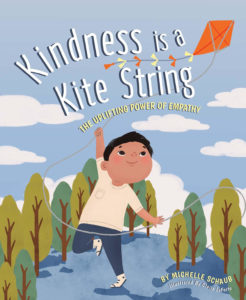“Using Similes and Metaphors to Spark Conversations about the Power of Empathy”
One of the most important things we can do as parents and educators is encourage kids to be kind. Not only does fostering a culture of kindness and empathy create a positive learning environment, but it also improves kids’ sense of well-being and agency. Besides, spreading kindness makes the world a little brighter. And who doesn’t want that?
How can you cultivate kindness, both in the classroom and at home?
One simple way to develop this much needed virtue is by sharing books that model kind behavior. My picture book, Kindness is a Kite String, does just that. The book starts with the words, “Kindness is like sunshine, it starts the day off right” and shows a child hugging his mom. This starts a wave of kindness that ripples through the community, connect diverse groups of people. As readers follow the story, they gather ideas for ways they can lift others with kindness.
Building Connections with Similes and Metaphors
Each action in Kindness is a Kite String is described using a simile or metaphor. For example, “Kindness is an open door to welcome others through,” and “Kindness runs like dominoes. Reach out and tip a tile.” As a writer and teacher, I know that similes and metaphors are powerful tools. They unlock readers’ imaginations and inspire mental pictures. Similes and metaphors build connections that promote understanding. They help kids comprehend something unfamiliar or abstract (like kindness) by comparing it to something they know well (like sunshine or an open door). In this way, similes and metaphors go hand in hand with kindness. When you act with kindness, you also bridge the gap between something familiar (yourself) and something that might seem new or different (others).
Kindness is a Kite String packs a double educational punch. Not only does the book help spark conversations about empathy, but it also provides models of similes and metaphors in action. That’s good news, considering knowledge of figurative language, including similes and metaphors, is part of the ELA Common Core Standards starting in grade three. However, this concept is often introduced with even younger kids.
Kindness is…
How can you use Kindness is a Kite String to reinforce the concept of similes and metaphors?
One way is by creating a collective “kindness poem.” I have found writing collective poems to be a very effective and engaging strategy to use with students. In a collective poem, each child contributes a line according to a provided prompt or rule. Collective poetry is a great warm-up writing activity because it invites all students to participate without the pressure of having to compose an entire poem from the get-go. It’s also an effective way to explore different perspectives on a topic, like kindness.
After reading KINDNESS IS A KITE STRING with your class, take some time to define and review similes and metaphors. The Authors Note at the back of the book will help you do this. Then provide the provide the prompts, “Kindness is like…”(for similes) and/or “Kindness is… (for metaphors.) If you’re working with students in person, you can write this prompt on the board. If you’re working with students remotely, try posting the prompt with an online program like Padlet or Flipgrid. Ask students to think of something that they enjoy doing or something makes them happy. Ask them how this activity or object might relate to kindness. After modeling some possible responses, invite each student to contribute their own simile or metaphor to complete the prompt. String the student responses together and you’ll have a kindness poem to display in your classroom or home.
Here’s an example of a kindness poem I started with second and third graders:
Kindness is
a cuddly kitten-
it makes you feel warm and cozy.
Kindness is like
a trampoline
bouncing happiness from one person to another.
Kindness is
Lego bricks
because kind deeds build on one another.
Kindness is like
a bowl of popcorn
because it’s meant to be shared.
Not only will your kindness poem remind kids to act with kindness, but it will also serve as great student-created examples of similes and metaphors.
Continue the Kindness Chain
There are many other ways Kindness is a Kite String can spark conversations about the power of empathy. The front of the book includes prompts to use before, during, and after reading. For example, one prompt says: “The last line of the book is ‘When you catch it, pass it on.’ Ask your child what kindness they have caught. What can they do to pass it on?” A free Readers Guide, downloadable from my website, also accompanies the book. It includes activities like a printable Kindness certificates and a kindness journal for kids to log their empathetic actions.
You can continue to reinforce kindness by exploring other recent picture books with themes of empathy, including Evie’s Field Day, by Claire Noland, Be Kind, by Pat Zietlow Miller, The Big Umbrella, by Amy June Bates, and Scribble Stones, by Diane Alber.
I hope I’ve inspired you with some new ways to promote kindness with kids. After all, as I say at the end of Kindness is a Kite String, “kindness is contagious. When you catch it… pass it on!”
Kindness is a Kite String: The Uplifting Power of Empathy
Author: Michelle Schaub
Illustrator: Claire LaForte
Published April 1st, 2021 by Cardinal Rule Press
About the Book: Cultivating kindness is easy when you try. Spread a little kindness and watch empathy ripple through the community… spreading happiness like sunshine, connecting diverse groups like a footbridge and lifting hope like a kite string.
How can YOU lift others with kindness?
This compelling book illustrates simple, yet impactful ways, to spread kindness and brighten the lives of others. Through poetry, the inspiring words uplift young readers, planting seeds of empathy, kindness and community support.
The best book for positively teaching kindness.
Kindness is a Kite by Michelle Schaub carries the key message of kindness as well as how to teach similes and metaphors supported by the many advocates of positive parenting solutions. It’ll sit comfortably on your shelf alongside other books that focus on the power of kindness.
This book comes with a free Reader’s Guide for children. The guide is available for free download from the publisher website. Lesson plans, activities and discussion questions to allow parents, teachers and caregivers to explore the topic further and deepen comprehension.
About the Author: Michelle Schaub is an award-winning children’s author and language arts teacher. Her previous books include Dream Big, Little Scientists, Finding Treasure: A Collection of Collections, and Fresh-Picked Poetry: A Day at the Farmers’ Market. Her poems appear in several anthologies, including Great Morning! Poems for School Leaders to Read Aloud. Michelle speaks at conferences on the power of poetry to boost literacy. Michelle lives near Chicago, where she loves finding creative ways to cultivate kindness.
Thank you, Michelle, for writing this book for kids. Kindness and empathy are what is going to change this world–thank you for opening up the conversation more!


